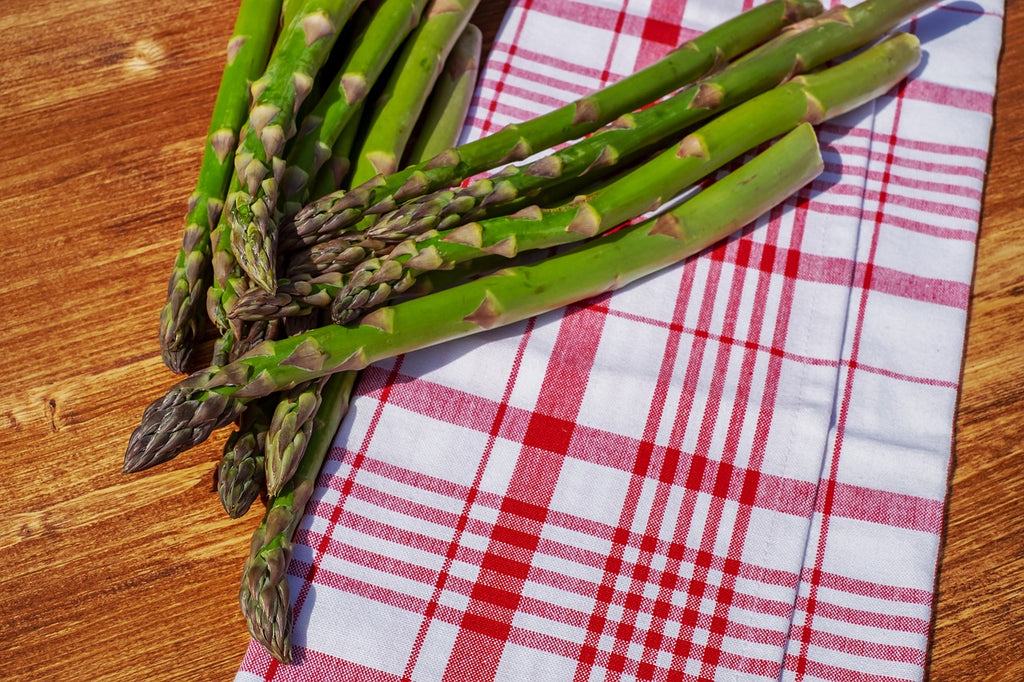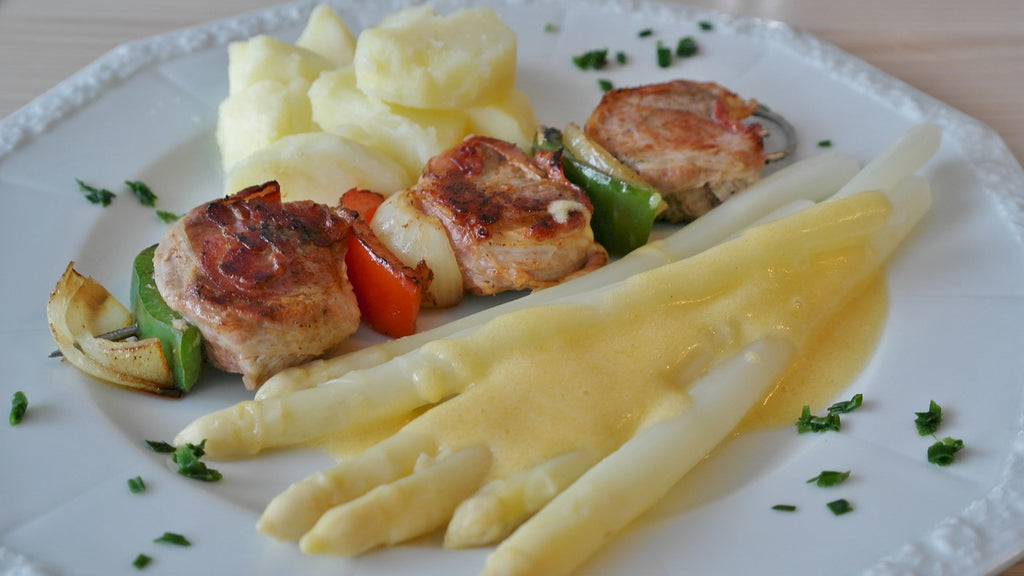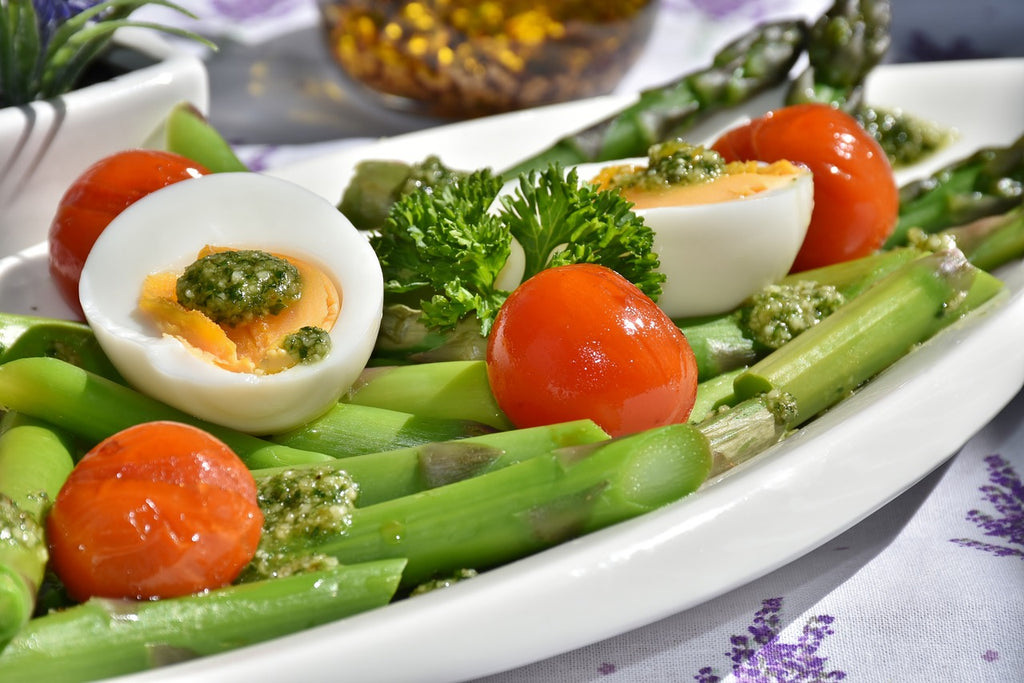Learn How to Cut Asparagus and Get That Crunch
 A good knife is a great start for cutting vegetables like asparagus.
A good knife is a great start for cutting vegetables like asparagus.
- Asparagus can be used whole after a proper trimming.
- There are also a variety of ways you can cut asparagus.
- Asparagus can be used in many different dishes, depending on how it’s cut.
Asparagus is quite a versatile vegetable. It can be the star of its own dish, or it can be a healthy and tasty complement to a wide array of dishes. Its hearty, earthy flavor puts it in the heavyweight category of vegetables. Like most green veggies, it packs a quality nutritional punch and can find its way into just about any dietary lifestyle.
Although asparagus used to be a purely seasonal vegetable, asparagus season is now year-round in most western grocery stores. This is due to the increase of asparagus plants grown in the southern hemisphere, leading to wider seasonal availability.
Before using asparagus, however, you'll need to prepare it. There are a few steps you must take to ensure your asparagus will taste and crunch like it's meant to.
Step 1: How to Trim Asparagus
 Asparagus needs to be trimmed before you can use it.
Asparagus needs to be trimmed before you can use it.
Before doing any cutting, you'll need to wash your fresh asparagus thoroughly to remove any dirt. Dirt is usually found toward the bottom of the plant. Rinse the asparagus spears with cold water and dry them with a paper towel.
Afterward, you'll want to remove the white, woody ends of the asparagus stalks. These are the fibrous, chewy bits that you don't want to bite into. To remove them, you'll need three things:
- A cutting board
- Your knife of choice (we recommend a chef's knife or a santoku knife)
- Your asparagus spears
Lay your asparagus on the cutting board so that the ends line up evenly. If you're using a chef's knife, around 8 spears should be the right amount to get with one cut. Cut off the white part of the stalks and discard them. If you have more asparagus to cut, repeat the process until you've trimmed the entire batch.
If the stalk is extra woody or thick, you may want to peel it as well. This usually applies to asparagus stalks that are thicker than average.
Although you could accomplish this task with a vegetable peeler, it can also be done with a paring knife. Lay the asparagus stalk on your cutting board and use your knife to slice the outer layer off. Make sure to cut away from yourself to avoid injury. Turn the stalk over and repeat the process until the woody outside is peeled away.
If you're using white asparagus you'll need to peel the outside since the outer layer is much thicker and more fibrous than that of other varieties. The same technique applies.
Step 2: Cutting Your Asparagus
How you intend to cook asparagus will largely determine how you should cut it. Different asparagus recipes will call for different cuts — and realistically, you can get creative with this vegetable since it's fairly versatile.
Asparagus Spears
 White asparagus goes very well with grilled or roasted meat.
White asparagus goes very well with grilled or roasted meat.
The easiest way to cut your asparagus is, well, to simply leave it alone. Once you've trimmed them, all you need to do is make sure they're dry. Asparagus spears are great for grilling or roasting and make a robust complement to other grilled foods like steak.
You can marinade your spears before grilling or roasting them to give them an extra flavor kick.
Chopped Asparagus
 Chopped asparagus can be used in a myriad of dishes.
Chopped asparagus can be used in a myriad of dishes.
Asparagus can also be cut into smaller pieces to make it easy to add to many different recipes. Line up the spears on your cutting board and cut the stalks into roughly 1/2-inch to 2-inch cylinders. You can accomplish this with several spears at a time using your chef's knife or santoku. In fact, lining up the spears will give you attractive, even cuts that a chef would be proud of. If you're using a knife with a shorter blade like a paring knife or a utility knife, you'll need to cut fewer stalks at a time.
If you're using a chef's knife, place the end of the blade on the board and rock backwards across the asparagus spears. If you're using a santoku, start with the blade perpendicular to the board and slice down while pushing forward. Repeat this process up to the tip, which you'll want to leave intact for aesthetic value.
Asparagus cut this way can be used in lots of different dishes. It can be thrown into a stir-fry to give a healthy crunch, or it can be added raw to salads to bulk them up. You can sauté it with olive oil, garlic, and mushrooms for a delicious accompaniment to a meat dish. Or you could use it to make a vegan asparagus soup or other veggie dishes.
Diagonal Slicing
 Diagonally sliced asparagus gives more surface area and, some say, more flavor.
Diagonally sliced asparagus gives more surface area and, some say, more flavor.
Instead of cut cylinders, asparagus spears can be sliced diagonally. By slicing the spears diagonally, you'll give your asparagus more visual appeal and feel like you're dining in a high-end restaurant.
The angle you cut them at is up to you, but we recommend a roughly 45-degree angle. You can line up your spears as described above. This time, instead of holding your knife perpendicular to your cutting board, hold it at an angle and slice until the asparagus is in long, thin strips.
You can use your chef's knife or santoku for this — or if you want to be extra careful, use your paring knife and cut one stalk at a time. It depends on the level of preciseness you desire and your skill with a knife.
This technique can be especially useful if you're using stalks of various thicknesses and you want your asparagus to have an even cook time. Additionally, some chefs would claim that cutting the spears diagonally allows more of the flavor to come out. We'll leave that claim up to you to decide on, but cutting asparagus diagonally certainly allows for more surface area.
Kitchen Essentials for Cutting Asparagus
Having a sharp knife and a good cutting board is one of the best ways to guarantee your asparagus comes out looking nice. A dull knife risks crushing the vegetables rather than cutting them, leading to bruising and uneven cuts. A sharp knife, on the other hand, glides through vegetables and helps you make even cuts.
The cutting board you use can be surprisingly impactful as well. We all know how frustrating it is when vegetables roll off the board and fall onto the counter or, worse yet, the floor. Using a trenched cutting board reduces this risk by employing gravity as your friend and ally. Any stray pieces will roll towards the deeper end of the board.
The Grass Is Green
Asparagus has long been cultivated in the western world because, well, it's tasty. Thanks to modern transport methods, you can now eat it any time you please.
Learning how to cut it correctly gives you ample opportunity to use it in a huge number of dishes. Essentially any dish that calls for green vegetables can have asparagus added to it.
Using the right knife to cut your asparagus will make your life in the kitchen easier and guarantee greater success in creating even, attractive cuts. Using a good knife isn't just for asparagus — it's for anything that happens in the kitchen. Happy cooking.








